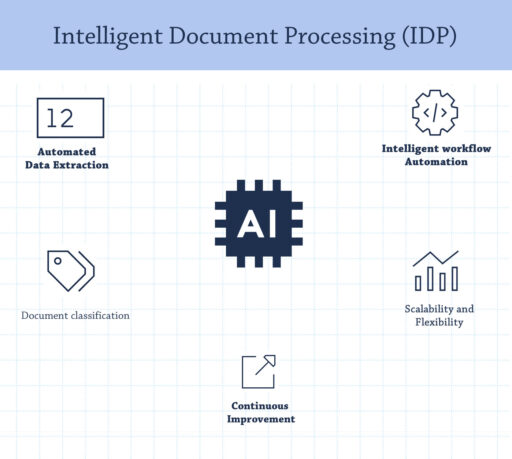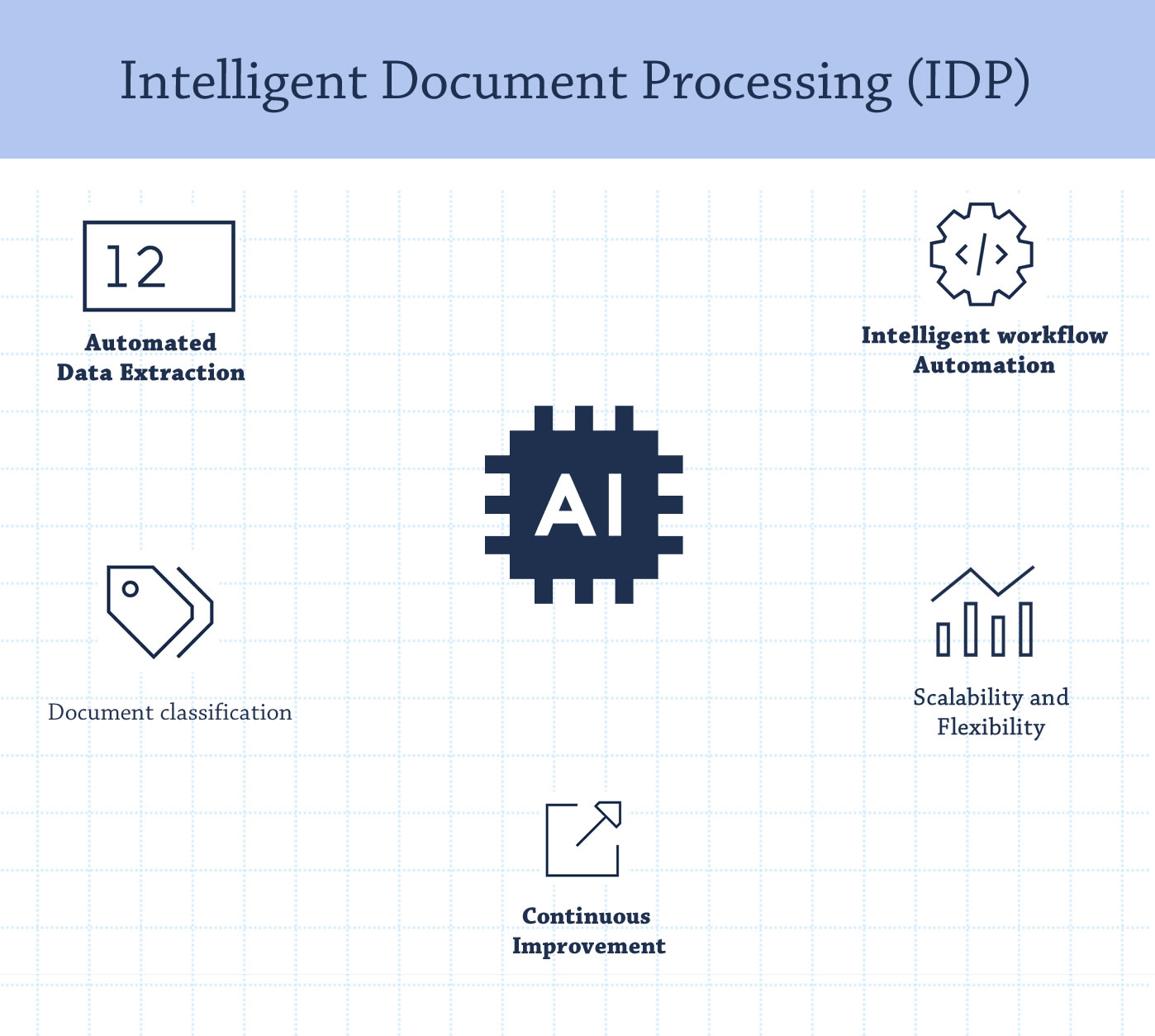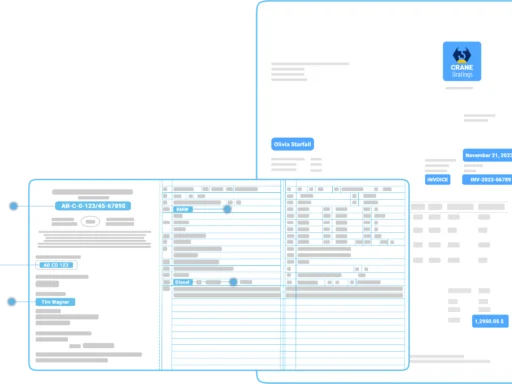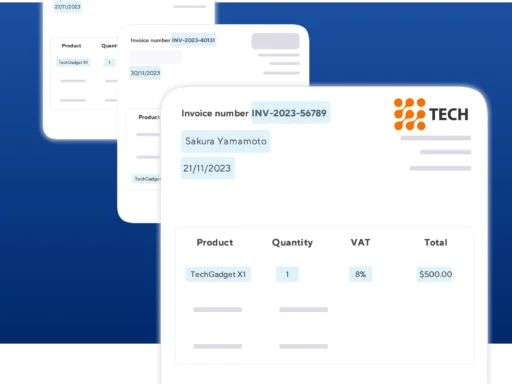Learn what Intelligent Document Processing (IDP) is and how it works. Discover how IDP leverages AI and machine learning to automate data extraction, classification, and workflow automation, significantly improving the accuracy and efficiency of managing large volumes of documents.
Efficient document management and related data processing are crucial for a company’s productivity and success.
Table of Contents
- What is Intelligent Document Processing (IDP)?
- IDP vs. ADP: What’s the Difference?
- Components of Intelligent Document Processing (IDP)
- Key Technologies of Intelligent Document Processing (IDP)
- Benefits of Intelligent Document Processing (IDP)
- Applications of Intelligent Document Processing (IDP) in Various Industries
- Challenges of Intelligent Document Processing (IDP) and Their Solutions
- How to Choose the Right IDP Solution for Your Business
- Conclusion
Over the years, document processing has evolved from manual handling to digital storage, and now to advanced technologies like Intelligent Document Processing (IDP).
IDP efficiently leverages AI and machine learning (ML) to automate and optimize document processing. It goes beyond traditional methods by integrating natural language processing (NLP) and advanced analytics.
This allows IDP to efficiently process structured, semi-structured, and unstructured data, such as handwriting.
Traditional document management systems based on outdated OCR technology face increasing challenges such as manual errors, inefficiencies, data silos, and security issues.
The AI and ML capabilities of PaperOffice DataExtractor address these problems by automating complex tasks, improving accuracy, and enabling real-time processing.
👉 This blog provides a comprehensive overview of Intelligent Document Processing (IDP), its components, benefits, applications, challenges, and how it works.
What is Intelligent Document Processing (IDP)?
💡 Intelligent Document Processing (IDP) is a technology that utilizes artificial intelligence (AI) and machine learning to automate the extraction, classification, and processing of data from various document types.
Unlike traditional document processing methods, IDP can handle a wide range of document types, including structured, semi-structured, and unstructured data.
IDP enhances efficiency, accuracy, and scalability in managing large volumes of documents, making it an indispensable tool for modern businesses.
Intelligent Document Processing (IDP) leverages AI to automate document processing, significantly improving accuracy and efficiency.
AI-powered IDP systems automate data extraction from various document formats, understand context, and identify key-value pairs, enabling precise data extraction from unstructured and semi-structured documents.
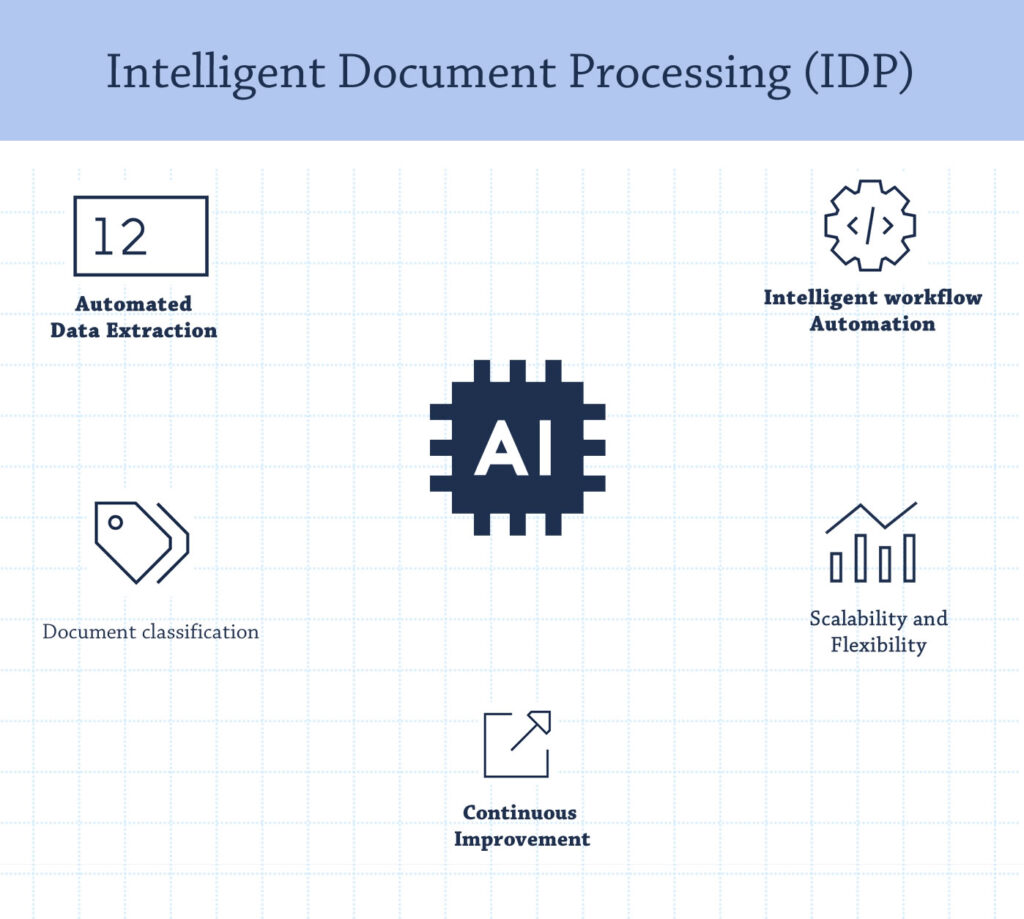
IDP automatically classifies documents and continuously learns, reducing errors and minimizing the need for manual sorting.
This technology also supports intelligent workflow automation, fraud detection, and compliance, offering scalability and flexibility. It dynamically adapts to new conditions, ensuring continuous improvements in document processing.
IDP vs. ADP: What’s the Difference?
Both Intelligent Document Processing (IDP) and Automated Document Processing (ADP) simplify document management, but they differ significantly in their capabilities and approaches.
IDP uses advanced technologies like AI, machine learning, NLP, and advanced analytics to process data from structured, semi-structured, and unstructured documents.
It is highly adaptable, continuously improves accuracy through machine learning, and efficiently scales to handle large data volumes. IDP integrates with various business systems and offers enhanced security features.
ADP, on the other hand, is based on basic automation and rule-based processes. It is limited to structured data, less flexible, and provides only basic error detection and security measures.
While ADP is simpler to implement, it requires manual updates and has limited scalability.
Components of Intelligent Document Processing (IDP)
Intelligent Document Processing (IDP) consists of several key components that work together to automate and optimize document management processes.
These components ensure that data is accurately captured, validated, stored, and integrated into business processes.
1️⃣ Data Capture: Techniques such as Optical Character Recognition (OCR), Intelligent Character Recognition (ICR), and Optical Mark Recognition (OMR) are used to extract text and data from various document types, including printed, handwritten, and marked documents. Image preprocessing techniques like noise reduction and skew correction enhance the accuracy of data capture.
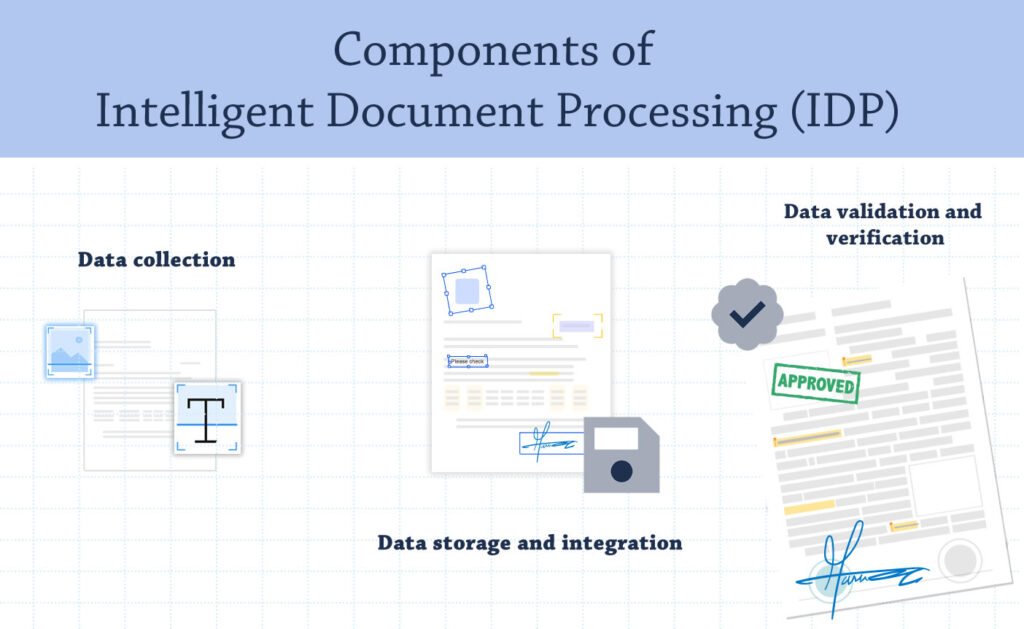
2️⃣ Data Validation and Verification: This step ensures the accuracy and integrity of the captured data.
Automated validation techniques check the data against predefined rules and external databases. AI-powered anomaly detection identifies inconsistencies, while automated corrections resolve common errors.
💡 This process ensures that the data complies with business standards and maintains high quality.
3️⃣ Data Storage and Integration: Documents are categorized and indexed for easy retrieval and integrated into business systems like PaperOffice Classic Document Management System, ERP, and CRM. Robust security measures, such as encryption and access controls in an OnPremise DMS, protect sensitive information.
Key Technologies of Intelligent Document Processing (IDP)
Key Technologies of Intelligent Document Processing (IDP)
Intelligent Document Processing (IDP) utilizes several key technologies to automate and optimize the document management process.
These technologies enable the extraction, classification, validation, and integration of data from various document types.
Optical Character Recognition (OCR): OCR is a fundamental technology in IDP that converts printed documents into searchable and editable data. OCR is essential for text digitization, helping businesses transition from paper-based to digital workflows.
PaperOffice, as a specialist in data processing and storage, integrates advanced OCR technologies to ensure high accuracy and efficiency in data capture.
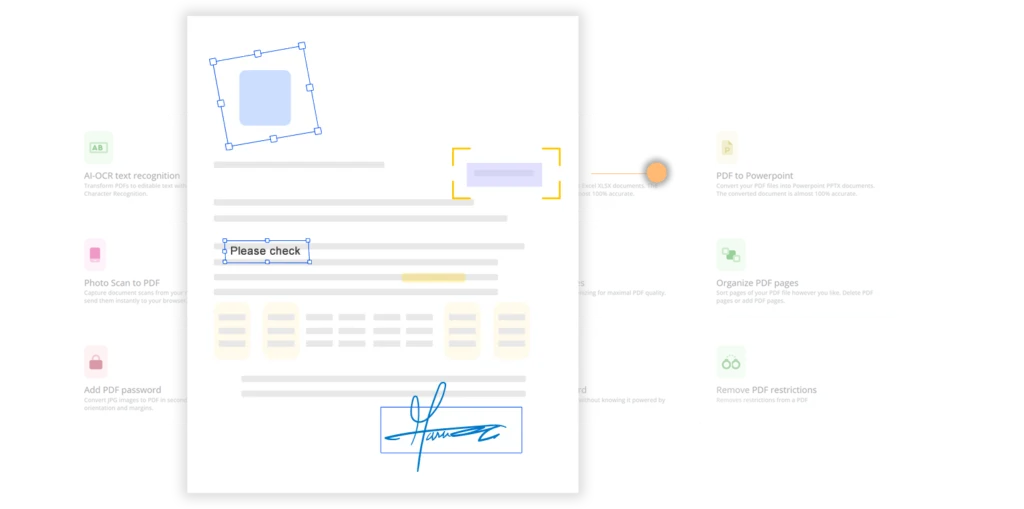
Machine Learning and Artificial Intelligence: These technologies enable IDP systems to learn from data and improve over time. Machine learning analyzes historical data to identify patterns and make predictions, while AI automates complex tasks such as data extraction and classification.
PaperOffice leverages these advanced technologies to precisely identify relevant data fields from various document types and detect anomalies, ensuring data integrity and compliance.
Natural Language Processing (NLP): NLP allows computers to understand, interpret, and generate human language. In IDP, NLP is used to analyze and process text data in documents.
PaperOffice employs NLP techniques to understand the context and meaning of texts, enabling accurate classification and extraction of relevant information.
Robotic Process Automation (RPA): RPA complements IDP by automating repetitive tasks related to document processing. PaperOffice integrates RPA to automatically trigger workflows based on extracted data, reducing manual intervention and accelerating processing.
Cloud Computing: Cloud computing provides the necessary infrastructure to handle the large volumes of data processed by IDP systems.
PaperOffice offers cloud-based solutions with the highest security standards, hosted in Germany at its own data centers and with external partners like Hetzner Online GmbH and Strato AG.
Our partners process all data according to strict data protection regulations, ensuring all information remains within the EU/EWR.
💡 The data centers in Germany, Switzerland, Finland, and Spain are optimized for local access, low latency, and certified security, ensuring safe and efficient document processing.

Benefits of Intelligent Document Processing (IDP)
Intelligent Document Processing (IDP) offers numerous advantages that significantly optimize business operations:
Increased Efficiency: IDP automates data capture, classification, and processing, allowing employees to focus on more value-added tasks.
Higher Accuracy: By leveraging AI, errors are minimized, improving data quality for better decision-making.
Cost Reduction: IDP reduces the need for manual interventions, saving labor costs and minimizing error correction expenses.
Faster Processing: Real-time data processing shortens turnaround times and improves responsiveness.
Security and Compliance: With robust security measures, IDP protects sensitive data and ensures compliance with regulations.
Seamless Integration: IDP easily integrates with ERP and CRM systems, enhancing collaboration and improving data accessibility.
Scalability: IDP grows with the needs of the business and handles large volumes of data effortlessly.
Better Decision-Making: Accurate, timely data enables informed, data-driven decisions.
Customer Satisfaction: Faster, more accurate handling of customer inquiries boosts satisfaction and loyalty.
Environmentally Friendly: By digitizing document processes, IDP reduces paper usage and supports sustainable business practices.
For more information, read our EXPERT Guide on the benefits of Intelligent Document Processing.
Applications of Intelligent Document Processing (IDP) in Various Industries
Intelligent Document Processing (IDP) is applied across numerous industries to optimize specific processes:
Finance and Accounting: IDP automates the extraction and processing of financial data from documents like invoices and reports, reducing manual input and speeding up reconciliation.
Human Resources: IDP simplifies employee data management by analyzing resumes, extracting information, and supporting the hiring process.
Legal: IDP enhances document management by automatically categorizing legal documents and ensuring compliance with regulations.
Healthcare: IDP automates patient information processing, improves data security, and accelerates the handling of insurance claims.
Supply Chain and Logistics: IDP streamlines the processing of shipping documents, ensuring accurate information flow, improving efficiency, and enhancing supply chain transparency.
We recommend taking a look at our use cases of Intelligent Document Processing in various industries.
Challenges of Intelligent Document Processing (IDP) and Their Solutions
Implementing Intelligent Document Processing (IDP) comes with some challenges, but targeted strategies can address them effectively:
Integration Complexity: Integrating IDP into existing IT systems can be difficult. A solution is to choose IDP systems with robust APIs and implement them step-by-step to minimize disruptions.
Data Quality: Varying document formats can affect data quality. Machine learning and preprocessing techniques help improve the accuracy of data capture.
Data Privacy and Security: Protecting sensitive data is crucial. IDP systems with encryption, access controls, and compliance with data protection standards are essential.
Implementation Costs: The initial implementation can be expensive. Cloud-based solutions and flexible pricing models offer cost-effective alternatives.
Operational Challenges: Resistance to change and a lack of skilled personnel are common issues. Strong change management and comprehensive training can ease the transition.
We recommend reviewing our “10 Examples of Intelligent Document Processing” for further insights.
How to Choose the Right IDP Solution for Your Business
When selecting the right Intelligent Document Processing (IDP) solution for your business, several key factors must be carefully considered to ensure it meets your specific needs. Here are the main aspects to consider:
1. Evaluate Your Business Requirements ✅
Start by identifying your company’s document processing needs. Determine the types of documents you handle, the volume of data to be processed, and the specific tasks you need to automate.Understanding your business requirements helps you choose an IDP solution that aligns with your operational goals and workflows.
2. Assess Technological Features ✅
Explore the technological capabilities of different IDP solutions. Look for features like Optical Character Recognition (OCR), Intelligent Character Recognition (ICR), and Natural Language Processing (NLP).Ensure the solution can process structured, semi-structured, and unstructured data. Advanced AI and machine learning capabilities are essential for continuous improvement and accuracy.
3. Integration with Existing Systems ✅
Ensure the IDP solution integrates seamlessly with your existing business systems like ERP, CRM, and document management systems.Compatibility with legacy systems and the ability to connect with other software through APIs are crucial for smooth data flow and operational efficiency.
4. Scalability ✅
Consider the scalability of the IDP solution. As your business grows, so will the volume of documents and the need for data processing.Choose a solution that can scale to handle larger volumes without compromising performance. Cloud-based IDP solutions often offer better scalability and flexibility.
5. Security and Compliance ✅
Data security is critical when handling sensitive information. Ensure the IDP solution provides robust security measures, including encryption, access controls, and audit trails.Also, verify that the solution complies with relevant industry regulations and standards, such as GDPR, HIPAA, or other data protection laws applicable to your business.
6. User-Friendliness ✅
A user-friendly interface is essential for the successful adoption of any new technology. The IDP solution should be intuitive and easy to use, requiring minimal training for your staff.A well-designed interface boosts productivity and shortens the learning curve for employees.
7. Vendor Support and Training ✅
Consider the level of support and training offered by the IDP provider. Reliable customer support is crucial for resolving issues during implementation and use.Comprehensive training programs and detailed documentation can help your team use the IDP solution effectively.
8. Cost and ROI ✅
Evaluate the costs of the IDP solution, including initial setup, licensing, and ongoing maintenance fees. Conduct a cost-benefit analysis to understand the potential return on investment (ROI).While upfront costs may be significant, the long-term benefits of increased efficiency, accuracy, and cost savings can justify the investment.
9. Customization and Flexibility ✅
Every business has unique document processing requirements. Ensure the IDP solution offers customization options to tailor the system to your needs.Flexibility in configuring workflows, validation rules, and data extraction parameters can enhance the solution’s effectiveness.
10. Performance and Accuracy ✅
Review case studies, customer testimonials, and pilot tests to assess the performance and accuracy of the IDP solution.High accuracy in data extraction and processing is crucial for maintaining data integrity and achieving desired results.
Conclusion
💡 Intelligent Document Processing (IDP) is revolutionizing document management by utilizing advanced technologies such as AI, machine learning, and NLP to automate and enhance data extraction, validation, and integration.
IDP significantly boosts efficiency, accuracy, and productivity across various industries by addressing data accuracy, integration complexity, and security challenges.
Choosing the right IDP solution requires careful consideration of business needs, technological capabilities, and scalability. Implementing IDP can help companies streamline operations, reduce costs, and improve decision-making.
IDP will drive digital transformation and operational excellence, ensuring businesses remain competitive in a dynamic landscape.
Are you ready to transform your document processing with cutting-edge IDP solutions? Discover how PaperOffice can simplify your workflows, improve data accuracy, and increase productivity.
PaperOffice Trial Version
Test the award-winning PaperOffice for 14 days without obligation at:
https://www.paperoffice.com
Social Media
Facebook: https://www.facebook.com/paperoffice.en
Twitter: https://twitter.com/PaperOffice_en
LinkedIn: https://www.linkedin.com/company/paperoffice-smart-ai-suite
PaperOffice ComDesk
Find out more at:
https://help-en.paperoffice.com
YouTube
► http://www.youtube.com/c/PaperOfficeEN
PaperOffice Blog
https://blog-en.paperoffice.com
Benjamin Kluge ist seit über 6 Jahren bei PaperOffice im Bereich der Automatisierung dank KI-Implementierung tätig. In seiner Freizeit verfasst er Artikel über Intelligente Dokumentenverarbeitung (IDP) und teilt sein Fachwissen zu den neuesten Trends in der Automatisierung und künstlichen Intelligenz.
